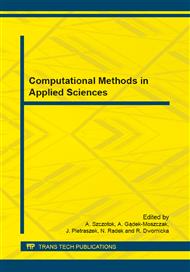[1]
L. Radziszewski, M. Kekez, Classification of fuel injected into cylinder of internal combustion engine by computational intelligence methods, in: R. Dwornicka et al., Modeling of dynamic systems, Kraków, 2014, pp.42-61. (in Polish).
Google Scholar
[2]
L.S.G. Teixeira et al., Multivariate calibration in Fourier transform infrared spectrometry as a tool to detect adulterations in Brazilian gasoline, Fuel 87 (2008) 346–352.
DOI: 10.1016/j.fuel.2007.05.016
Google Scholar
[3]
M. Kekez, L. Radziszewski, Modelling of pressure in the injection pipe of a diesel engine by computational intelligence. Proceedings of the Institution of Mechanical Engineers, Part D: Journal of Automobile Engineering (2011) 0954407011411388.
DOI: 10.1177/0954407011411388
Google Scholar
[4]
R. Isermann, N. Müller, Design of computer controlled combustion engines, Mechatronics (2003) 1067-1089.
DOI: 10.1016/s0957-4158(03)00043-6
Google Scholar
[5]
M. Yoon et al., A method for combustion phasing control using cylinder pressure measurement in a CRDI diesel engine, Mechatronics (2007) 469-479.
DOI: 10.1016/j.mechatronics.2007.06.001
Google Scholar
[6]
J. Pietraszek, A. Gądek-Moszczak, N. Radek, The estimation of accuracy for the neural network approximation in the case of sintered metal properties, Studies in Computational Intelligence 513 (2014) 125-134.
DOI: 10.1007/978-3-319-01787-7_12
Google Scholar
[7]
J. Pietraszek, N. Radek, K. Bartkowiak, Advanced statistical refinement of surface layer's discretization in the case of electro-spark deposited carbide-ceramic coatings modified by a laser beam, Solid State Phenomena 197 (2013) 198-202.
DOI: 10.4028/www.scientific.net/ssp.197.198
Google Scholar
[8]
J.R. Quinlan, Data mining tools See5 and C5. 0, http: /www. rulequest. com/see5-info. html.
Google Scholar
[9]
J.R. Quinlan, C4. 5: programs for machine learning, Morgan Kaufmann, (1993).
Google Scholar
[10]
M. Kekez, L. Radziszewski, Fuel recognition in compression ignition engine in the real time, Pomiary Automatyka Kontrola 59 (2013) 470-472.
Google Scholar
[11]
A.P. Engelbrecht, Fundamentals of computational swarm intelligence, John Wiley & Sons, (2006).
Google Scholar
[12]
Information on http: /www. particleswarm. info/Programs. html.
Google Scholar


